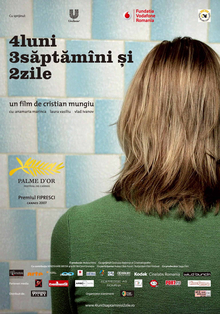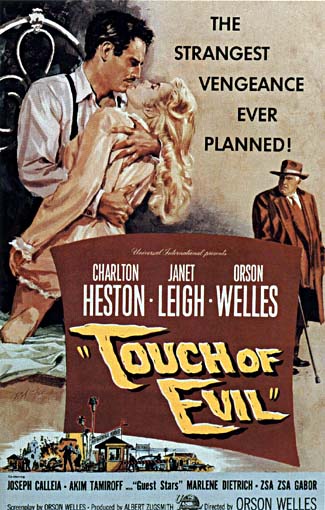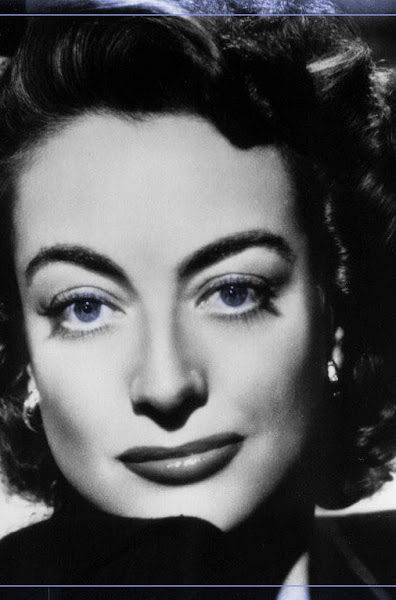 *** ½ out of ****
*** ½ out of ****
“4 Months, 3 Weeks, and 2 Days” is a powerful, evocative film that dares to challenge conventional morals and filmmaking, ultimately crafting a moody, suspenseful, real, and sometimes gruesome picture. The color of each scene is remarkably bleak, with good reason; an abortion is no happy matter.
In the film, two young women, college roommates named Otilia and Gabita, try to arrange an illegal abortion for Gabita. After Otilia arranges the entire event at a nearby hotel, the pair meets shady Mr. Bebe for the life-changing procedure. What happens afterward will arrest the attention of audiences until the surprising end.
The film features stunning performances from its actors, but Otilia (Anamaria Marinca) in particular, whose role is raw and inspired. This hardly neglects Gabita (Laura Vasiliu), though, who played her foolish character to perfection. “4 Months” relies intensively on its script for action, with heavy dialogue carrying the plot. Though few films can be carried for two hours on words alone, this one grasps the attention of viewers and never lets go. Being so completely dialogue-driven, musical sound has hardly a place in this film, and it is noticeably absent. All that happens in this film must be accomplished by what is spoken or what is not spoken in the silence.
The film’s greatest achievement besides script and direction is in a partnership of cinematography and editing, where the takes are incredibly long and the framing depends on utilizing shots that involve characters applying offscreen space. This film is all about hiding and maintaining secrets, and with a dialogue-driven story, conversations that take place with characters outside the shot enhance the sense of secrets. Again, though lengthy, deliberate shots can become quite boring after some time, this film ceaselessly maximizes its capacity for captivation with each shot. Going back to dialogue, it is also particularly useful for maintaining the interest level of these shots, and it is also important to note again that both what is seen and what is spoken incorporate something to hide by enhancing silence and offscreen space.
Cristian Mungiu makes a fantastic film, but with its laudable filmmaking, there are a few less-than-praiseworthy things worth mentioning. Though almost completely dead-on with its dialogue, the narrative leaves some important questions unanswered. If a viewer is like me, I am certain he or she is also wondering who Gabita’s baby’s father is, though some viewers may not. Though it is clear that the film’s focus is in the now and not on what happened or what will happen, such details being removed makes me recall the 1993 film, “Philadelphia,” which raised many of the same questions, removing much of the main character’s past in favor of the issue at hand. Although this does work for “4 Months,” it is not entirely satisfying for viewers to leave the theater questioning such details. Despite the uncertain past, at least the film incorporates a similarly uncertain future for the characters at the film’s end. This complete uncertainty, though, can be rewarding as far as the film is concerned, but it is hardly as rewarding to viewers.
Overall, viewers will be on the edge of their seats for most sequences. I should also mention that this film is not for viewers who become easily queasy—some sequences hold nothing back.
“4 Months, 3 Weeks, and 2 Days” is now showing at the Belcourt Theater.
Originally published in the March 27 issue of Versus Magazine: Entertainment & Culture
March 27, 2008
4 Months, 3 Weeks, & 2 Days (4 luni, 3 săptămâni şi 2 zile)
March 26, 2008
The Band's Visit (Bikur Ha-Tizmoret)
 *** ½ out of ****
*** ½ out of ****
“The Band’s Visit” is a charming Israeli film by first-time director Eran Kolirin, who makes a masterpiece with his first time at bat. With Arab-Israeli tensions still affecting the world today, Kolirin takes audiences on a journey beyond geographic, linguistic, and cultural boundaries with ordinary people who find friendship in each other.
In the film, an Egyptian police band travels to Israel to play at the opening of an Arab Cultural Center, but ends up lost in a small town full of some humorous people and laugh-out-loud adventures. In the vein of comedies like “Napoleon Dynamite,” this one takes an all-too-funny approach at humor by slowing the wit and making viewers appreciate each paced moment. Some of the funniest scenes come from slow and awkward moments, particularly when Haled schools an Israeli boy on how to be nice to his unfortunate, unattractive date at the roller rink and when the band’s clarinetist mournfully plays everyone his unfinished “concerto.”
Defying expectation is one of the greatest attributes of comedy, as well, and it is achieved in the man who waits day and night at the pay phone for his love to finally call. In fact, the entire film relies on the characters, whose individual quirkiness generates the overall humor. Superior acting definitely plays a role in achieving the film’s humor based on character, and the actors who play Tewfiq, Dina, and Haled, in particular, finely-tune their characters’ attributes to perfection.
From the first shot of the film, an establishing shot on a white van fit snugly between two columns, there seems to be a sense of confinement, and after the van rolls away, the neatly-lined Egyptian police band in the background stands between two more columns, further hinting at this idea. The type of confinement they represent is perhaps geographic and cultural, particularly since the whole group always looks so out-of-place wherever they are at the beginning of the film, but while cinematography threatens to confine these characters, they depend on reaching past confinement for understanding.
Tewfiq, who is frequently mistaken for a General, outwardly represents the Arabic militant opposition that endlessly inflicts Israelis. His persona, instead, reveals a human who hardly resembles the Israel perception of the group to which he belongs. When Tewfiq first meets Dina, she casually says, “Here there is no Arab culture. Also, no Israeli culture. Here there is no culture at all.” She intends to promote the film’s intention of breaking down cultural barriers to reveal the humans underneath. The characters can only communicate in the international standard language of English, which does represent another barrier for the two parties, but it proves that by reaching past barriers comes understanding, and understanding is what is required of these characters (and humans, in general) in learning about each other.
Overall, with incredible humor and a human message, “The Band’s Visit” represents a triumph of the human spirit.
“The Band’s Visit” is now playing at the Belcourt Theater.
Originally published in the March 20 issue of Versus Magazine: Entertainment & Culture
Oscar-Nominated Live Action Short Films '07
The Academy Award for the Live Action Short Film falls in with the most unrecognized awards of Oscar night. The miniature counterparts of Best Picture nominees and usually as first-rate as those films, they too often fall through the cracks because of their lack of promotion outside of film festivals or art house theaters. Because of this, they also miss the attention of the average American who complacently enjoys the newest box office smash. Despite this, this forthcoming Sunday will herald a new winner, and out of the following five films, I believe one will attain this distinguishment.
“The Substitute” is an Italian short about a seemingly crazy man who decides to substitute teach until he is found out and revealed to be a businessman who chooses the wrong day for fun. The film’s first tracking shot aims to show the calamity of schoolchildren’s lives, but the following handheld mobile framing instead shows the calamity caused by the cool substitute teacher you always wish you had. The meeting room at the end of the film has a much more boring take on framing and editing, thus making the children’s world more visually dynamic compared to the adults’ world. This establishes the idea later that childhood is just a better place, more particularly because of the film’s clear moral: protecting what you value amongst temptation. Interesting and amusing, “The Substitute” is short, sweet, and to the point.
“Tanghi Argentini” is a little Dutch delight. Never lacking in humor, a clever matchmaker tries to learn the tango in order to impress a date, so he recruits his boss to show him the moves. This charming film is full of belly laughs.
An anguishing, tearful film, “At Night” is a masterpiece with a powerful script and flawless acting. Its mise-en-scène (light blue hospital rooms and dim lighting) and bleached tones contribute to the overall feeling of moroseness and somberness. Visually arresting, the frequency of close-ups and medium shots (among other fantastic shots) imparts a feeling of pain and reality in the three cancer-stricken women. The score frequents the idea of silence and its power in times of both happiness and grief. This director has complete control of the camera, and this story unfolds amongst perfection. If this one does not win the award, I will be completely surprised.
“The Mozart of Pickpockets” is a witty French film about a pair of unlucky pickpockets who lose three of their partners-in-crime and find a new one in a little deaf and mute boy. Clever in its use of off-screen space, this simple film keeps the laughs alive with its not-so-intelligent pickpocketing pair and one adorable child who confounds their work until he proves to be the titular “Mozart.” Funniest moment: the hilarious misspelling of “la maison” with “meson” and the corrective “mêson” when the little boy draws a house. Perfectly made, this film has the best chance of winning if the Academy goes “funny” again this year.
The British “Tonto Woman” is a fish among four sharks this year. The compassionate story follows a man who falls for a shunned, marked woman in the Old West and wants to help her. With creative stylistic effort in the Western dynamic, the film falls completely short everywhere else. Feeling, at best, like Hallmark’s next “hall-of-famer,” “Tonto Woman” is one big yawn with a poor story. This film is the weakest of the five films I watched; I could hardly make it through it.
The Oscars will air live on February 24th at 7 p.m. CST on ABC.
Originally published in the February 21 issue of Versus Magazine: Entertainment & Culture
NOTE: My second guess, "The Mozart of Pickpockets" won the Oscar.
Oscar-Nominated Animated Short Films '07
When you think of the Academy Awards’ greatest annual honors, you immediately think of Best Picture or Best Actor, but you would infrequently remember those films nominated for Best Animated Short Film. This year, five contenders from different countries and with different styles vie for this particularly underappreciated prize.
The first is the CGI-created French short film “Même les Pigeons Vont au Paradis,” which features a priest who tries to sell an old man a machine that will transport him to heaven. Featuring a fast-paced story with a clever theme of cheating others, this film has a surefire shot at garnering an Oscar.
Next is the breathtaking Russian beauty, “My Love.” In nineteenth-century Russia, a young man falls in love with a young girl and a mysterious older woman. The gorgeous animation, in the style of a painting, seems to help augment the effect of love on the story. Aleksander Petrov won an Oscar in 1999 in this category for “The Old Man and the Sea,” so his next effort, this film, has a great chance at snagging him another.
The first shot of Canada’s “Madame Tutli-Putli” features a long pan of old collectibles until it rests on the titular character. The film’s stop-motion animation is perfect in stiffening this character who seems so weighed down. Aboard the train, the way Madame moves tells a lot about her timid character. Her train ride, accompanied later by a haunting score, quickly turns into a nightmare complete with sexual innuendo and some terrifying creatures. This particular film’s target audience is not children, but its ingenuity (and incredible filmmaking) could garner it the Oscar.
In Canada’s other entry, “I Am the Walrus,” 14-year-old Beatles fan Jerry Levitan makes his way into John Lennon’s hotel room and records a brief interview with him. In the style of Gnarls Barkley’s “Crazy” music video, Lennon’s words are transformed into art by motion graphic design, both hand-drawn and digitally created. Through the art, this brilliant film is able to explore Lennon’s words and interpret them into meaning. The soundtrack is comprised entirely of the grainy, authentic interview. Having won at the AFIs seems to get the ball rolling in this film’s favor.
Finally, Britain’s “Peter and the Wolf” will receive my most favorable attention. With its model animation, director Suzie Templeton modernizes the age-old story of the young boy who just wants to explore the other side of his Grandfather’s locked fence. While reveling in the wintery wonderland there with the goofy goose and the little bird that cannot fly, he discovers a not so happy wolf, whose leitmotif is recognizably resurrected for most people by memories of Scut Farkus from TV’s perennial “A Christmas Story,” though it comes from Prokofiev’s original composition. What stands out to me in this film is the incredible filmmaking, including such techniques as crosscutting in editing and the dynamic angles in cinematography. Though the longest of the five films, its childlike quality through animal characters and simple plot capture the attention of audiences praying for the safety of Peter.
Each film has distinctly different qualities and utilizes different types of animation to tell the story, and though so completely and distinctly different, each film seems to have a pretty equal shot at nabbing the Oscar. My preference was “Peter and the Wolf,” but Academy voters might see differently.
The Oscars will air live on February 24th at 7 p.m. CST on ABC.
Originally published on insidevandy.com
NOTE: "Peter and the Wolf" did win the Oscar.
Touch of Evil
 *** ½ out of ****
*** ½ out of ****
No stranger to perfection, director Orson Welles achieves it again with his 1958 film noir masterpiece, "Touch of Evil." From the film’s first tracking shot to the extensive use of cinematography and stylistic functionality of mise-en-scène, Welles lives up to that notorious and legendary image as a consummate perfectionist, but one who knows how to, above all, realize artistry through the camera.
In the film, Vargas (Charlton Heston) plays an altruistic Mexican police officer trying to determine a drug ring’s connection to a car bombing on the U.S. border. Local members of the ring are trying to stop his efforts by going after his new bride, Susan (Janet Leigh), while corrupt U.S. police captain Quinlan (Welles) thwarts him by planting evidence and pointing fingers at others.
Heston seems to have enjoyed taking on roles with different cultural backgrounds, and this film is no different. The idea of him as a Mexican is somewhat laughable, but he does it well enough, though the character bears no real cultural distinction outside of the fact that he occasionally speaks Spanish in the film and has a stereotypical image. On the other hand, in the damsel-in-distress role, Leigh stays true to her career role preference. In fact, the film noir’s synonymous femme fatale is uncharacteristically absent in this film. Meanwhile, Welles’ tendency to play larger-than-life characters hardly changes in this film, as his presence as the obese, authoritative Quinlan eventually overshadows the acting of the pleasing protagonists, leading the film to center on him in the end.
Thrilling and enthralling, "Touch of Evil" leaves little to be desired, but what it does leave is notable. The prominent example is the fact that Vargas’ target drug ring seems to get lost in the plot in exchange for tackling Quinlan’s ultimate crisis of and Vargas’ crusade for morality. I also think the film’s ending was a bit too rushed for even the standard swift climax of film noir. "Touch of Evil" can be confusing, possibly losing viewers in its complexity, but it weaves the narrative well to deliver the encompassing theme of good versus evil.
I believe Welles to be one of the greatest directors of all-time cinematographically, and this film is no exception with its mastery of shot composition, employment of Welles’ trademark deep focus and deep space composition, and particular use of mobile framing. Sometimes the medium shots leave significant action off-screen, which helps to propel the suspense. In particular, the opening tracking shot, having been developed in 1941’s "Citizen Kane," is one of the most famous in film history, and its perfectly-timed choreography in mobility, coupled amongst diegetic sounds makes it a riveting symphony in terms of artistry and suspense. The film consistently utilizes low angles in shots, which seems to translate a continuous sense of dominance, but perhaps in the respect of self-righteousness, which characters like Quinlan always express.
Keeping with the style of other film noir, lighting tends to focus heavily on shadow, at times completely hiding characters, which functions to portray evil in characters like Quinlan or impose evil on characters like Susan.
Welles was one of the most underappreciated directors of all time, but his films still command significant respect, and this one is no different. A superior effort into film noir, Welles puts together a visually breathtaking film against a dark narrative with magnificent results.
Originally published in the February 7 issue of Versus Magazine: Entertainment & Culture
The Diving Bell & The Butterfly (Le scaphandre et le papillon)
 *** ½ out of ****
*** ½ out of ****
"The Diving Bell and the Butterfly" is an extraordinary film that packs a visceral punch, thanks in no small part to outstanding cinematography, fantastic acting, and a genius director. "The Diving Bell," a splendidly superior film, deservedly nabbed Best Foreign Film at last week’s Golden Globes. The film, based on a true story, is one of the great creative achievements of last year’s cinema because it combines every element of filmmaking into a masterpiece.
In "The Diving Bell," Jean-Dominique Bauby was once the successful editor-in-chief of Elle magazine in France, but a debilitating stroke has left him paralyzed from head to toe at the somewhat young age of 43. Bauby cannot function anymore, but a brilliant therapist has developed a method of allowing him to blink in order to communicate to the world. With the blinking technique, he tells the world his own life-story while audiences share the pain of his entrapment.
Director Julian Schnabel, with his history in the art world, channels his creative energies into this film, his third, with a prowess and style that are not usually synonymous with a director with such a small list of cinematic efforts. Schnabel’s "Diving Bell" seems to draw influences from some classic films, including the films of Spanish director Luis Buñuel (1972’s "The Discreet Charm of the Bourgeoisie"). Buñuel is remembered for his characteristic surrealist style, and "The Diving Bell" features some surrealistic flights of fantasy in Bauby’s mind. One other film inspiration seems to be something like Lars Von Trier’s 1996 masterpiece, "Breaking the Waves," which contributes its bleached-out coloring to many scenes in "The Diving Bell," alluding to the hopelessness of Bauby’s post-stroke plight.
The film’s editing is fantastic, helping the sound to weave perfectly in and out between two contrasting scenes, such as a fantasy scene and the real life narrative. "The Diving Bell" also boasts a fantastic adapted screenplay that assists and complements the rich visuals. Last but certainly not least, the acting is absolutely top-notch, particularly Mathieu Amalric as Bauby and Marie-Josée Croze as Henriette, his brilliant speech therapist. Amalric is almost indistinguishable from his paralyzed character, and Croze is perfect as the sympathetic and emotional Henriette.
The cinematography in "The Diving Bell and the Butterfly" is exquisitely first-rate. With shots coming primarily from Bauby’s point-of-view, the film captures audiences in his body, forcing them to sympathize and share his pain. The abundance of close-up shots, with their tight framing, also encloses viewers within his own confines, forcing them to further identify with his perspective. Most notably, the abundant use of mobile framing allows for the freedom of movement, which cruelly contrasts to the fact that Bauby is incapable of movement.
The greatest theme of the film is obviously the need for escapism, and many motifs in the film reflect on it. Scenes with a man trapped in a deep sea diving suit at the bottom of the ocean and scenes with butterflies eagerly swarming about are intersected within specific scenes of the film. The suit with a slow zoom-out generates feelings of isolation and entrapment while the butterflies inspire freedom, showing how Bauby is connected to the former while longing for the latter. The recurrence of Empress Eugenie in Bauby’s fantasies connects him to a figure whose past chains her to the same hospital from which he cannot escape. The recurrence of the French version of Bobby Darin’s classic "Beyond the Sea" introduces the idea of escapism in the opening credits since the abyss of the sea represents the greatest metaphorical prison in the film, so the song is a foreshadowed cry for freedom. The final motif is the recurring images of the glacier crashing into the ocean. The "sinking" indicates a symbolic representation of entrapment, but when the glacier reverses and rises out of the sea in the end credits, it is a symbolic reference to the freedom of Bauby’s soul from his body.
Do not miss this film because it could very well be one of the best you will see this year.
Originally published in the January 31 issue of Versus Magazine: Entertainment & Culture

.jpg)

.jpg)
.jpg)
